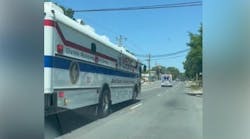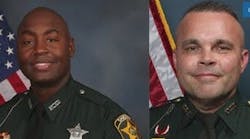Oct. 27--If you've attended a Carolina Panthers game or run in an uptown 5K recently, there's a good chance images of you were captured by Charlotte-Mecklenburg police cameras and stored on department servers.
After beefing up their camera network in advance of September's Democratic National Convention, police now have access to more than 500 surveillance cameras perched on traffic lights, mounted on buildings and focused on sensitive areas across the city.
But what they don't have is a rule book giving officers clear guidance on how best to use their expanding power to watch the city's streets and residents. A team of police officers, technicians and lawyers is literally writing it now, even as department leaders make plans to move the cameras to new corridors and crime-plagued communities.
Civil liberties advocates and civil rights activists worry the cameras will invade the privacy of law-abiding residents and raise the risk of racial profiling in high-crime areas.
"They're not going to be in Ballantyne. They're not going to be on Rea Road or out in Myers Park. We know where they're going to be," said James Ferguson, a prominent Charlotte civil rights attorney. "More likely than not, they will be placed in areas that are labeled high-crime areas, and that becomes a surrogate for racial minority areas."
Police say they have no plans to profile people by race or invade their privacy. They say the cameras simply expand their reach.
Several areas of town can be monitored simultaneously by an officer at a computer terminal, said Deputy Chief Harold Medlock, who led the department's DNC security planning. The cameras can be used to determine where crime is happening -- or not happening -- and help police leaders more efficiently position officers on duty.
"Time after time, these things have helped us catch thieves breaking into cars, we've caught strong-armed robberies, we've caught fights," Medlock said. "We've had homicides or shootings and we've gone back and looked at camera data."
As the department looks to expand its use of cameras, leaders are creating standard operating procedures based on practices camera operators have been using for more than a decade, said Capt. Steve Willis.
"What we're utilizing the cameras for is to observe criminal activity in public spaces," he said. "We're not looking into windows of apartment complexes, we're not monitoring the balconies. We're not looking into pools."
City Council member Andy Dulin, a Republican, said he supports the expansion of the camera program, but added that he understands "some folks might have a problem with privacy."
"But we're not restricting anybody's freedom of speech or freedom of movement through the city," Dulin said. "We should give the department whatever the police think they need. I would recommend people not do something illegal."
Surveillance spread quickly
Charlotte joins a growing number of cities using surveillance cameras. Chicago, for instance, had an estimated 10,000 cameras by 2011. Baltimore had more than 500, concentrated in the city's downtown area.
A study by the Urban Institute last year said use of the cameras has spread so fast authorities haven't been able to do thorough studies of their impact on crime. The Urban Institute study examined camera systems in Chicago, Baltimore and Washington, D.C., and found that crime did drop in many areas after cameras were installed.
Charlotte police began their camera program in 2000, installing about a dozen cameras around uptown. The department wanted better surveillance as the center city became a weekend entertainment destination, Medlock said.
The department also focused cameras on parking lots to crack down on thefts from cars, the city's most prevalent crime.
Later generations of cameras were wireless, so police didn't have to string wire back to a control center. That brought down the costs of camera networks.
Later, the Charlotte Department of Transportation added cameras to monitor traffic flow at key intersections. And police gained access to those cameras.
Politicians go, cameras stay
By 2011, when Democrats announced they would hold their presidential nominating convention in Charlotte, police could pull up images from 400 cameras, mostly in the Central Division, which includes uptown.
That number increased to more than 500 cameras by the first day of the convention.
Charlotte's not the only city to add cameras for a political convention.
Denver's police department had 13 cameras recording its downtown before the 2008 DNC. By 2010, the department was monitoring more than 100. Tampa Bay bought 119 cameras before the Republican National Convention, according to the Tampa Bay Times.
Across the bay, in St. Petersburg, 26 cameras purchased for the RNC have been shelved while the city council decides what to do with them.
The CMPD's Medlock said some of Charlotte's newest cameras are focused on the airport and places where high-profile dignitaries stayed during the DNC.
Officers are still deciding which cameras to move, and to where. Medlock said the department will look at crime trends for help. The department isn't seeking input from the public or from the City Council -- steps other departments have taken in setting up surveillance policies.
The department also has to deal with physical constraints, like whether a tree or building blocks a view of a crime hotspot, or whether a camera has access to steady electrical power. Cameras won't peer into private buildings or homes, police say.
Still, some critics suggest the cameras should be retired entirely.
"There's nothing that says simply because you have cameras that you have to use them, particularly when you think about the potential for harm when you go out with a solution and look for a problem," Ferguson said.
"It's not just an expectation of privacy, but it's also a question of to what extent do we allow government intrusion to go unchecked. ... We're talking about using cameras because we've got them, not because we need them."
What the police can see
The cameras, typically encased in white plastic, peer out at the world from behind a transparent dome that protects the lens from the elements as well as vandals. They cost between $8,000 and $8,500.
Medlock said he didn't know the costs of maintaining the network and paying the officers who watch the cameras, which come with a three-year warranty. The Urban Institute study said that in Baltimore, costs from maintenance and vandals exceeded the initial investment.
Most of the cameras connect wirelessly to a secure police network, which can only be accessed from police headquarters. Two rooms are packed with advanced video surveillance monitors. One room is a command center built just for the DNC.
Chief Rodney Monroe told the Observer that the department uses the room four or five days a week. During a tour by the Observer earlier this month, the room was being used by a team focused on repeat offenders.
The cameras "don't have super-duper capabilities," Medlock said. They don't have facial recognition software or a night-vision mode, like cameras other departments use. They can't see infrared.
But they can pan and tilt and zoom, or scan in a fixed pattern. They work well in low light, but typically can't capture a night-time image without a streetlight nearby.
Medlock directed an officer to zoom in as far as he could on a man standing in front of the main uptown bus terminal, facing Time Warner Cable Arena. A clear image of the man's face, clothes and dreadlocks appeared on a high-definition television.
"We rarely zoom in that far," Medlock said.
But another camera, pointed at a northern Charlotte parking lot prone to thefts from vehicles, caught an image of a man in black pants and a white shirt. This camera was positioned farther away, and even fully zoomed in, couldn't capture a clear image of the man's face.
"I don't really care what you look like if you're walking through a parking lot with a brick in your hand," Medlock said. "The activity is what draws our attention. If somebody is standing very still from a close camera location, you can get into face. But I want to look at direction of travel. I want to know what they're wearing. I want to know if there's a piece of rebar in your hand."
The department keeps the camera data for 30 days unless it's flagged as part of an investigation, Capt. Willis said.
Who watches the police?
The N.C. chapter of the American Civil Liberties Union is worried that decisions about how to use the cameras will be made solely behind the walls of the police department, without public oversight or input.
"Operating 500 cameras and monitoring 500 cameras is not something that's going to be inexpensive. And we don't know exactly how beneficial those cameras are in regards to crime prevention, and whether the benefit is equal to the cost, both financially but also in regards to the loss of privacy," said Chris Brook, the group's legal director.
Members of a Charlotte City Council subcommittee that deals with police matters said they have not been briefed on the department's plans for the cameras. Members Claire Fallon and Dulin both said they thought the expanded camera use would help fight crime, but added that they were sensitive to privacy concerns.
"I think we would be very interested in knowing where it goes and why it goes there," Fallon said of the cameras. "I know I'll be asking that question." Staff researchers Marion Paynter, Maria David, the St. Petersburg Times and the Denver Post contributed.
Wootson: 704-358-5046; Twitter: @CleveWootson
Copyright 2012 - The Charlotte Observer


